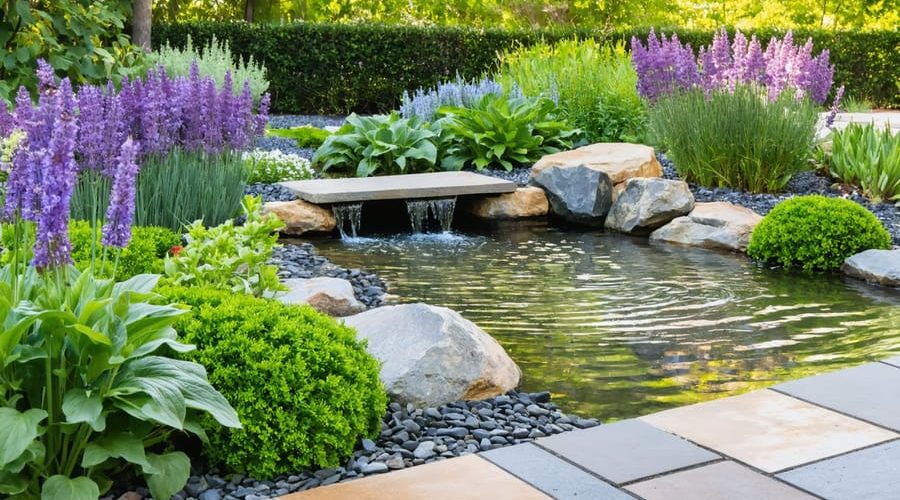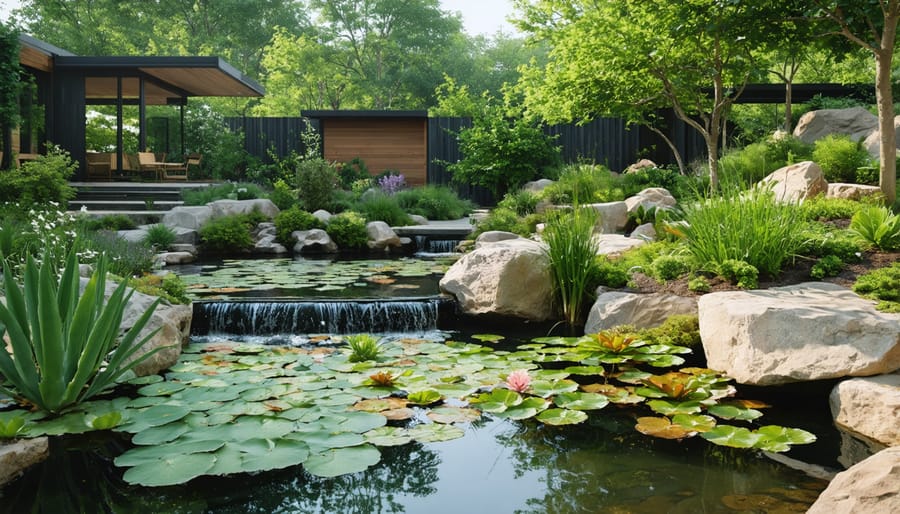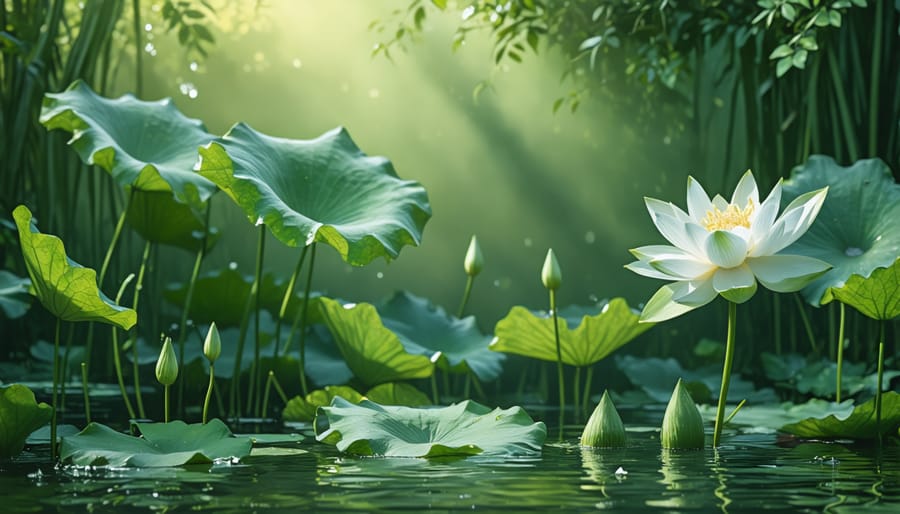
Smart Seasonal Planting: How to Create a Thriving Water Garden That Uses Less Water
Transform your garden into a water-efficient oasis by grouping plants with similar water needs together, creating distinct hydrozones that maximize every drop. Installing a drip irrigation system delivers water directly to plant roots, reducing waste by up to 50% while preventing leaf diseases caused by overhead watering. Layer your soil with 2-3 inches of organic mulch to retain moisture, suppress weeds, and create a thriving ecosystem that requires less frequent watering.
Water-wise gardening merges smart design with nature’s wisdom, allowing you to maintain a vibrant landscape while conserving precious resources. Choose drought-resistant perennials like lavender, sage, and native species that thrive in your local climate, naturally requiring less supplemental watering once established. Position these plants strategically, placing those with higher water needs in naturally moist areas or shade, while utilizing sunny spots for drought-tolerant varieties.
Creating a sustainable water garden isn’t about sacrifice – it’s about working smarter with nature’s patterns. By incorporating these principles, you’ll cultivate a garden that not only survives but thrives with minimal water input, proving that responsible resource management and stunning landscape design go hand in hand.
Understanding Your Water Garden’s Seasonal Needs

Climate Zones and Water Garden Microclimates
Understanding your local climate zone is crucial for creating a successful water garden that conserves resources. Different regions experience varying rainfall patterns, temperature ranges, and humidity levels, which directly impact your garden’s water needs and plant selection.
In hot, arid climates, focus on drought-resistant aquatic plants and consider incorporating shade elements to reduce water evaporation. Desert gardeners might want to include deeper pools and enhanced circulation systems to maintain cooler water temperatures.
Humid subtropical areas can support a wider variety of water plants but may need careful management during intense summer heat. Consider creating different depth zones in your water garden to accommodate various plant species and their specific needs.
Cool-climate gardeners should select cold-hardy aquatic plants and may need to protect certain species during winter. Adding windbreaks and strategic placement of your water garden can create beneficial microclimates that protect sensitive plants and reduce water loss through evaporation.
Remember that even within your yard, different areas create unique microclimates. South-facing locations typically need more water, while areas sheltered by buildings or trees might retain moisture better. Use these natural variations to your advantage when planning your water-wise garden.
Water Conservation Principles for Different Seasons
Effective water conservation strategies change with the seasons, and adapting your garden care routine accordingly is crucial for maintaining a water-wise garden year-round. During spring, focus on mulching beds heavily to retain moisture and installing rain barrels to capture natural precipitation. Consider setting up a drip irrigation system to deliver water directly to plant roots.
Summer demands careful attention to watering schedules – water deeply but less frequently, and always in the early morning or evening to minimize evaporation. Use moisture meters to monitor soil conditions and avoid overwatering. Group plants with similar water needs together to prevent waste.
Fall is ideal for adjusting irrigation systems and preparing for cooler weather. Add organic matter to improve soil water retention and consider installing rain gardens to maximize natural water use. In winter, reduce watering frequency but maintain consistent moisture for evergreen plants. Check irrigation systems for leaks and protect exposed pipes from freezing.
Remember to adjust your automatic watering systems with the changing seasons and weather patterns. This proactive approach ensures your garden stays healthy while minimizing water waste throughout the year.
Spring: Starting Your Water-Wise Garden Right
Early Spring Plant Options
Early spring offers excellent opportunities for establishing water-efficient plants in your spring water garden design. Consider drought-tolerant perennials like Creeping Thyme, which creates a beautiful ground cover while requiring minimal water. Sedum varieties, particularly Autumn Joy and Dragon’s Blood, are perfect choices as they store water in their thick leaves and provide early-season interest.
Lavender is another fantastic option, offering both water efficiency and delightful fragrance. Plant it in well-draining soil and enjoy its purple blooms throughout the season. For shaded areas, try Heuchera (Coral Bells), which comes in various colors and maintains its beauty with limited watering.
Don’t overlook native plants like Echinacea (Coneflower) and Black-Eyed Susan. These hardy performers establish quickly in early spring and develop deep root systems that help them thrive with natural rainfall alone. For texture and movement, ornamental grasses like Blue Fescue work wonderfully, requiring minimal maintenance while adding year-round interest to your water-wise landscape.
Spring Planting Techniques
Spring is the perfect time to establish water-wise plants, and with the right techniques, you can minimize water waste from day one. Start by planting during cooler morning hours to reduce evaporation and transplant shock. Before placing your plants, create shallow basins or berms around each planting area to help capture and direct water to the roots.
When removing plants from their containers, gently loosen the root ball to encourage outward growth. Plant at the same depth as the container soil level, and add a layer of organic mulch around each plant, leaving a few inches of space around the stem. This mulch layer is crucial for retaining moisture and suppressing water-hungry weeds.
Group plants with similar water needs together to prevent overwatering some while underwatering others. Consider using polymer moisture crystals in the planting holes to retain water near the roots, especially for thirstier plants. Water deeply immediately after planting to eliminate air pockets and help roots establish contact with surrounding soil.
For the first few weeks, monitor soil moisture carefully, but resist the urge to overwater. New plants need consistent moisture to establish, but overwatering can lead to shallow root systems that are less drought-resistant in the long run.
Summer: Managing Peak Water Demands
Heat-Tolerant Plant Selection
Choosing heat-tolerant plants is key to maintaining a beautiful garden while conserving water. Lavender, with its fragrant purple blooms, thrives in hot conditions and requires minimal watering once established. Salvia varieties add vibrant splashes of color and attract pollinators while being remarkably drought-resistant. Sedums, with their succulent leaves and late-summer flowers, store water naturally and can survive long dry spells.
For groundcover, consider creeping thyme or ice plant, both of which create dense mats of foliage that help retain soil moisture and prevent weed growth. Native plants like black-eyed susans and coneflowers have deep root systems that help them access water deep in the soil, making them excellent choices for water-wise gardens.
Mediterranean herbs like rosemary, sage, and oregano not only add flavor to your kitchen but also flourish in hot, dry conditions. For dramatic impact, ornamental grasses such as fountain grass or blue fescue provide movement and texture while requiring minimal irrigation. Remember to group plants with similar water needs together to maximize watering efficiency.

Summer Water Conservation Tips
During the hot summer months, smart water conservation becomes crucial for maintaining your water garden efficiently. Start by mulching heavily around your plants to retain moisture and reduce evaporation. A 2-3 inch layer of organic mulch can save up to 30% of your water usage.
Consider installing a rain barrel to collect natural precipitation – it’s free water for your garden! Cover your pond or water features with floating plants like water lilies, which help reduce evaporation while adding beauty to your space.
Water early in the morning or late in the evening when temperatures are cooler to minimize water loss through evaporation. Use drip irrigation systems instead of sprinklers for precise water delivery directly to plant roots.
Group plants with similar water needs together, creating hydrozones that make watering more efficient. Check for and fix any leaks in your irrigation system or pond liner promptly. Adding a layer of gravel or decorative stones around the pond’s edge can help retain moisture in the soil while creating an attractive finish.
Remember to monitor water levels regularly and top up only when necessary – overwatering is just as harmful as underwatering.
Fall and Winter: Preparing for Dormancy
Fall Transition Plants
As summer fades, transitioning your water-wise garden for fall doesn’t mean sacrificing beauty. Ornamental grasses like Feather Reed Grass and Blue Fescue become garden showstoppers with their golden plumes while requiring minimal water. Consider incorporating drought-tolerant Sedum ‘Autumn Joy’ and Rudbeckia for lasting color that supports your autumn garden preparation. Russian Sage and Verbena bonariensis add height and structure, attracting butterflies while staying resilient in drier conditions.
For ground cover, try Creeping Thyme or Ice Plant, which spread beautifully and suppress weeds without demanding much water. Japanese Anemones offer elegant blooms that persist through early fall, though they need initial establishment care before becoming water-wise. These transitional plants not only create visual interest but also help maintain soil stability as you prepare for winter, making your garden both beautiful and resource-efficient during the seasonal change.
Winter Protection Strategies
As temperatures drop, winter-proofing your water garden becomes essential for both plant health and water conservation. Start by adding a thick layer of mulch around sensitive plants to retain moisture and protect roots from freezing. For container plants, consider moving them to sheltered areas or wrapping the pots in bubble wrap for insulation.
Install floating pond heaters or de-icers to maintain a small opening in the ice, allowing for proper gas exchange while preventing excessive water loss through evaporation. Remove fallen leaves regularly to prevent decomposition and nutrient buildup in the water.
For exposed water features, consider using protective covers that allow light penetration while reducing water loss. Remember to check water levels regularly, as winter winds can still cause evaporation. If you have a pump system, either remove it or ensure it’s running at a reduced flow rate to minimize water waste while maintaining circulation.
Don’t forget to disconnect and drain any exposed irrigation lines to prevent pipe damage from freezing temperatures.

Rotation and Maintenance Schedule
A successful water-wise garden needs a well-planned rotation and maintenance schedule that adapts to each season. Start your year in late winter by pruning dormant plants and checking irrigation systems for leaks or damage. This is also the perfect time to plan your spring plantings and consider which areas might need updating.
As spring arrives, focus on establishing new plants when natural rainfall is more abundant. Group plants with similar water needs together, and apply a fresh layer of mulch to retain moisture. Check your irrigation timer settings and adjust them based on weather patterns and plant requirements.
Summer maintenance is crucial for water efficiency. Water deeply but less frequently to encourage deep root growth. Early morning watering minimizes evaporation, and regular weeding prevents unwanted plants from stealing precious moisture. Monitor your plants for signs of stress and adjust watering schedules accordingly.
Fall is the ideal time for dividing and relocating water-loving plants. Reduce watering as temperatures cool, and prepare your garden for winter by cleaning out debris and protecting sensitive plants. Install rain barrels now to capture winter precipitation for future use.
Throughout the year, maintain a monthly checklist: inspect irrigation systems, check mulch levels, monitor plant health, and adjust watering schedules based on rainfall and temperature. Keep records of what works well in different areas of your garden to fine-tune your approach over time.
Remember that a water-wise garden evolves with the seasons, and flexibility in your maintenance routine is key to success. Regular monitoring and small adjustments will help you create a thriving garden that uses water efficiently year-round.
Water-wise gardening is not just a trend; it’s a responsible approach to creating beautiful outdoor spaces while preserving our precious water resources. By implementing the strategies we’ve discussed, you can maintain a stunning water garden that’s both environmentally conscious and visually appealing.
Remember that success lies in choosing the right plants, implementing efficient irrigation systems, and maintaining proper water levels. Native and drought-resistant plants will naturally thrive in your local climate, while proper mulching helps retain moisture and reduce evaporation. Smart water features, like recirculating fountains and well-designed ponds, can actually help conserve water while creating peaceful ambient sounds.
Regular maintenance is key – check for leaks, adjust water levels seasonally, and keep your filtration system clean. Consider collecting rainwater and installing moisture sensors to optimize your watering schedule. These small steps add up to significant water savings over time.
By embracing water-wise gardening principles, you’re not just creating a beautiful outdoor space – you’re contributing to environmental sustainability and potentially reducing your water bills. Start small, experiment with different techniques, and watch your water-wise garden flourish. Your efforts will reward you with a vibrant, sustainable garden that serves as an inspiration to others in your community.
Remember, every drop counts, and your thoughtful approach to water gardening makes a real difference in preserving this vital resource for future generations.
